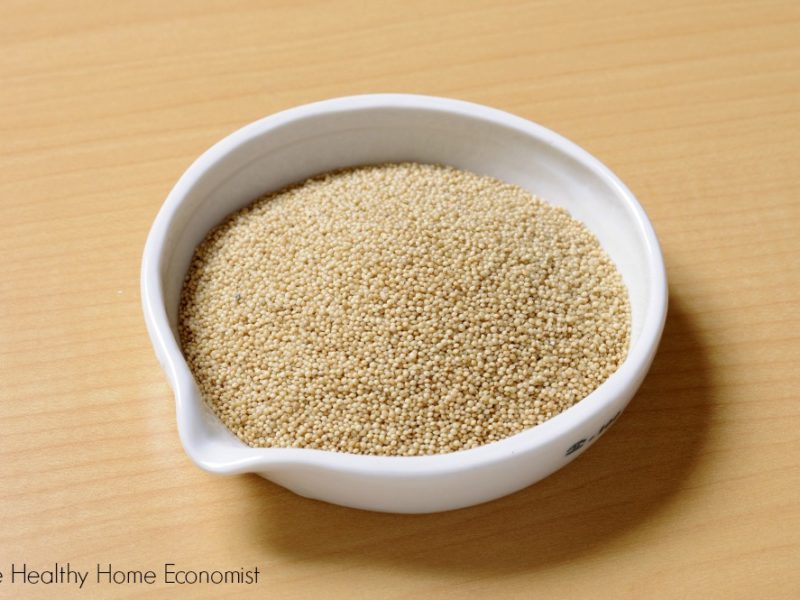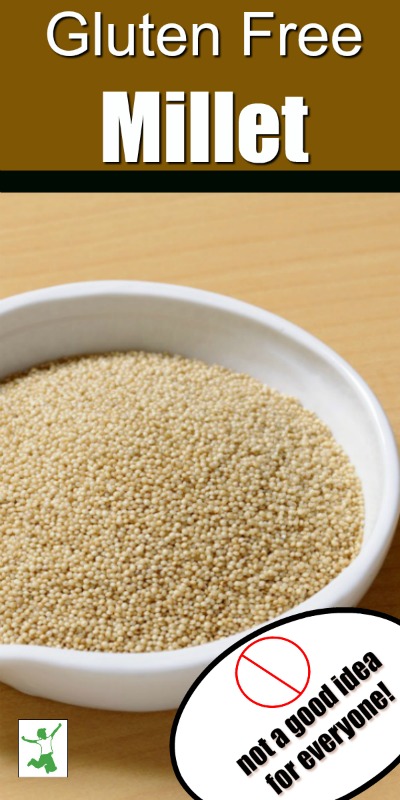Examination of why millet should optimally be eaten in moderation as a gluten-free whole grain in order to avoid disrupting hormone health.

Gluten allergies are clearly on the increase in our modern society. It seems like practically every other person I know these days has some sort of digestive issue that avoiding gluten would probably improve.
At the top of the list of gluten-containing foods is wheat. It is the indisputable, primary staple of the Western diet. Wheat is also the very foundation of the controversial USDA Food Pyramid.
Given how important bread and other wheat-based carbohydrates are to our society’s basic food requirements, it’s no wonder that folks seek a quick and easy substitute for wheat bread and wheat-based snacks when a gluten allergy or Celiac disease has been diagnosed.
Millet: Ancient Gluten-free Whole Grain
Enter millet. This ancient grain was cultivated in East Asia as far back as 10,000 years ago, according to archaeologists. Surprisingly, the cultivation of millet in prehistoric times was more prevalent than even rice, particularly in what is now China and the Korean peninsula.
Millet’s resistance to drought is perhaps the reason for its popularity in ancient times and its spread to Europe by 5000 B.C.
Despite the 5000 years cultivating this whole grain as a staple food, millet porridge is considered a traditional food in Russia as well as China. Use of millet is also widespread in Africa, like gluten-free teff, likely due to the drought-prone climate.
Millet Bread: Logical Substitute for Wheat
The protein structure of millet is quite similar to wheat. The one glaring exception is that millet is a gluten-free grain. Wheat contains copious amounts of this hard to digest plant protein.
When plain millet flour is used for baking bread (as opposed to homemade gluten-free flour or a healthy gluten-free flour mix from the store), the resulting loaf is light, white, and quite similar in texture to wheat bread. As a result, people who wish to avoid gluten tend to immediately gravitate to millet bread as the most logical and palatable substitute.
Millet bread is extremely popular in health food stores. Sami’s Bakery and Deland Bakery are two local bakeries that sell an absolute ton of millet bread to these stores around my local metro area.
I recently corresponded with a person up the East Coast of the USA who was consuming a lot of the millet/flax chips as an alternative to wheat-based snacks and had no idea of the potential health risks from consuming so much millet.
It was this discussion that led me to write this blog and warn folks about the dangers of consuming too much millet!
Potent Goitrogens
While millet does not contain gluten, it does contain goitrogens. These are substances that suppress thyroid activity and can lead to goiter. This condition involves enlargement of this very important gland which resides in the throat. Low iodine intake can also lead to goiter for those who rely on millet as a staple according to the Journal of Endocrinology and Metabolism.
Hypothyroidism is a serious and sometimes debilitating condition. It accompanies a weak or enlarged thyroid such as what occurs with goiter. Depression, difficulty losing weight, loss of hair, cold hands/feet, and fatigue are common hypothyroid symptoms. By some estimates, hypothyroidism is at epidemic proportions in Western society. (1)
Goitrogens in foods that contain them are usually reduced by cooking such as cruciferous vegetables like broccoli. However, cooking actually increases the goitrogenic effect of millet! Incidentally, the same effect occurs when fermenting soy.
Therefore, when folks begin eating large amounts of millet bread with a wholesale switch over from wheat, the thyroid suppressing effects of this simple dietary change can be profound. Injuring the thyroid can have a cascade effect on other glands as well. For example, those suffering from adrenal fatigue many times have thyroid issues as well.
Moderation is Critical
Protect your thyroid at all costs! It is a real challenge to unwind the effects of hypothyroidism once this vital gland is weakened or enlarged. Don’t take any chances with your thyroid health by consuming large amounts of millet bread or millet based snacks.
If gluten and/or wheat is a problem, then simply reduce bread consumption. Alternatively, use another grain that is both gluten-free and non-goitrogenic such as rice, oats or teff. Be sure to get quality, though, as rice is frequently high in arsenic.
Alternatively, try using grain-like gluten-free foods such as highly nutritious buckwheat, amaranth, or the starchy tuber cassava. They are excellent for baking too!
Millet bread consumption is fine in moderation if your thyroid is healthy – just don’t overdo it!
Given how difficult it is in modern society to maintain thyroid and overall glandular health, taking a chance by eating a lot of millet bread is a risky proposition indeed.
Traditional peoples did not have the constant stresses and strains on their glands like modern people do.
For example, they did not have to contend with pollution of their food, water, air and overall environment.
Therefore, we must be overprotective of our thyroid health. This includes avoiding regular consumption of foods that might impair it in any way.

Millet Alternatives That Preserve Thyroid Function
If you have thyroid issues and need alternatives to millet, here is a list of the healthiest options to consider.
- Einkorn Benefits (contains “good gluten“)
- Teff Benefits
- Yuca Root Benefits
- Arrowroot Benefits
- Wild Rice Benefits
- Farro (great if only modern wheat is the problem)








Goitrogens are found in a number of foods but in low levels. The levels may be higher in millet but the other health benefits of all of these foods are such that reducing or even cutting them out your diet can easily saddle you with a lot of other health problems. Well balanced diets even out the poor health effects of any food. Unless you have a serious problem with your thyroid do not take the article too seriously foods containing iodine will level out the goitregens just as the goitregens will level out the of too high an iodine diet. If you cut out all foods that have unhealthy effects then death by starvation will no doubt result. Such a death is not healthy.
In South Karnataka which is a part of southern India(300kms radius around bangalore) has been consuming Finger Millet as their Staple Food for thousand and thousand of years. They eat for breakfast, lunch and dinner. I do not see any Goitrogen effect. Anyone who consumes Finger Millet has the least health problem in this region. Please do not get panicked by this. Some time experience and history is better than research. Some thing missing in the research which cannot justify this Goitrogen effect in millet in this region
I agree with Sashi, Even in Tamil Nadu , south India , People ate only millets in their diet.I confirmed with my granny and she said they use to eat rice only in some festival times.Other days only millets were their only diet.Millet is called wonder grain.Please dont fall prey in some data in the internet.Both actual and opposite data will be available.So better surf every other source of information before beleiving in one single post.
Please include the wonder grain in your diet for living a healthy life.
How about pearl millet found in abundance in india and jowar?
ビジãƒã‚¹ãƒ“ューãƒãƒ¼
For many people dairy and animal products are more problematic than grains. Most healthy cultures do not eat a lot meat , but grains, beans etc.And is some even no dairy at all.
Important note. Bird seed is often Millet. Birds aren’t all getting Goiter or Health thyroid related problems are they? The rats are fed exclusively millet 95%. This can create Nutrient Deficiencies. These Deficiencies could cause problems for health. For example with many people a deficiency of Fat Soluble vitamins get many health issues. That doesn’t mean some toxic substance in those people’s diet is causing problems, rather the lack of a necessary nutrient. Lack of vitamin A can cause thyroid problems and 100 grams of millet contains 0% daily recommended intake of A, or E fat soluble vitamins..HOWEVER… the fact that unlike other grains, millet contains vitamin B -17, well known to cure cancer, is a strong motivation for a smear campaign of stupid lab tests to scare people away from millet. ( FACT: at least a dozen cancer cures have been suppressed as it’s a huge money making industry) Just eat a balanced diet including fat soluble vitamins (cold fermented cod liver oil) and I believe millet isn’t a problem. PS it seems grey colored millet is the worst according to the lab tests for anti thyroid affects, on the extremely restricted lab diet. I might be wrong but this is my current belief unless I learn more to change my mind. Ps thanks to the writer of this article as all facts should be researched and because of this article I’ve been doing some interesting research.
Thanks for the info. My research show almost all the tons of research papers about millet being bad for the Thyroid are probably only tested with Pearl Millet. Just 1 type out of at least 14 types of Millet!! Are all varieties of beans the same? Of course not! Why would all millets be the same? The anti-thyroid chemicals in the Pearl Millet are the Flavanoids which is from the Latin word Flavus meaning yellow. Pearl Millet is Yellow!! Why don’t you buy a healthy red millet such as Finger Millet, which has more calcium than milk (and any other food that I’m aware of), and is much healthier than Pearl Millet. Buy some 15% Lugols Iodine from Austrailia, (That strength was banned in America by corrupt officials on grounds that it could be used in a Meth lab to make drugs, Yeah right, as if that’s what people buy it for and a stick could be used to kill someone why don’t you ban sticks.) Supplement your Iodine and your good to go. Wash and drain millet or any grain before using as they do in Asia, you’ll drain colored water a few times till it stops coloring so easy, then cook or use. If you don’t feel safe, fine, do a grain free diet and don’t look back. It’s no big deal. A plate full of veggies and meat will fill you up and eat fruit, eggs, and milk or yogurt as well. You won’t even miss grains. Good luck.
A post at curezone from someone who experienced dental healing on a vegetarian
diet. He attributes a lot of that to millet.
http://curezone.com/forums/fm.asp?i=1892800#i
It looks like there are no hard and fast rules when it comes to health and healing.
How discouraging! I just switched to millet to offer a hearty side dish to my always-hungry husband and growing boys. For those of us trying to avoid inflammation, all grains (including rice) are out. Some people are saying now that oats are extremely toxic and should be completely avoided – read Cure Tooth Decay by Ramiel Nagel. Heavy sigh.